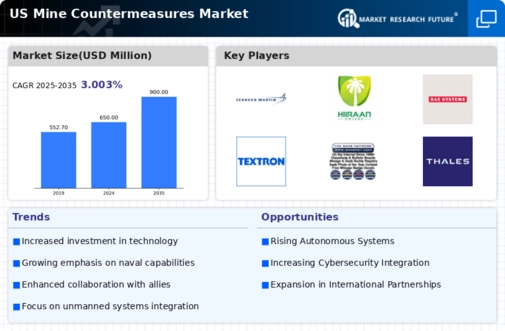Increased Defense Budgets
The mine counter-measures market is significantly influenced by the rising defense budgets of the U.S. government. In recent years, defense spending has seen a consistent upward trajectory, with an increase of approximately $20 billion allocated specifically for counter-terrorism and mine clearance operations. This financial commitment reflects a strategic focus on enhancing military capabilities and ensuring the safety of personnel in conflict zones. As funding becomes more readily available, companies within the mine counter-measures market are likely to benefit from increased contracts and opportunities for innovation. This trend indicates a robust future for the industry, as the demand for effective mine counter-measure solutions continues to grow.
Rising Geopolitical Tensions
The mine counter-measures market is experiencing growth due to escalating geopolitical tensions, particularly in regions where military operations are prevalent. Nations are increasingly aware of the threats posed by landmines and unexploded ordnance, leading to heightened demand for advanced counter-measure technologies. The U.S. government has allocated substantial budgets for defense, with a reported increase of approximately 5% in military spending in recent years. This trend indicates a commitment to enhancing national security, which directly influences the mine counter-measures market. As military operations expand, the need for effective mine detection and neutralization systems becomes paramount, driving innovation and investment in this sector.
Emerging Threats from Non-State Actors
The mine counter-measures market is being shaped by the emergence of non-state actors who utilize improvised explosive devices (IEDs) and landmines in asymmetric warfare. These threats have prompted the U.S. military to adapt its strategies and invest in advanced counter-measure technologies. The increasing frequency of such attacks has led to a heightened focus on developing effective detection and neutralization systems. As a result, the mine counter-measures market is expected to grow, with an estimated annual increase of 6% over the next few years. This trend indicates that the industry must remain agile and responsive to evolving threats, ensuring that solutions are both innovative and effective.
Technological Innovations in Detection
Technological advancements play a crucial role in shaping the mine counter-measures market. Innovations in detection technologies, such as ground-penetrating radar and unmanned aerial vehicles (UAVs), are revolutionizing the way mines are identified and neutralized. The integration of artificial intelligence (AI) and machine learning into these systems enhances their efficiency and accuracy. The U.S. military has reported a significant increase in the deployment of these advanced technologies, with a projected market growth of 7% annually over the next five years. This trend suggests that as technology continues to evolve, the mine counter-measures market will likely expand, driven by the need for more effective and reliable solutions.
Growing Awareness of Humanitarian Issues
The mine counter-measures market is also driven by a growing awareness of humanitarian issues related to landmines and unexploded ordnance. Non-governmental organizations (NGOs) and international bodies are increasingly advocating for mine clearance efforts in post-conflict regions. The U.S. has been actively involved in supporting these initiatives, contributing millions of dollars to demining programs worldwide. This humanitarian focus not only enhances the safety of affected populations but also creates a demand for advanced mine counter-measure technologies. As awareness continues to rise, the market is likely to see increased investment and collaboration between governments and NGOs, further propelling growth in the mine counter-measures market.

















Leave a Comment